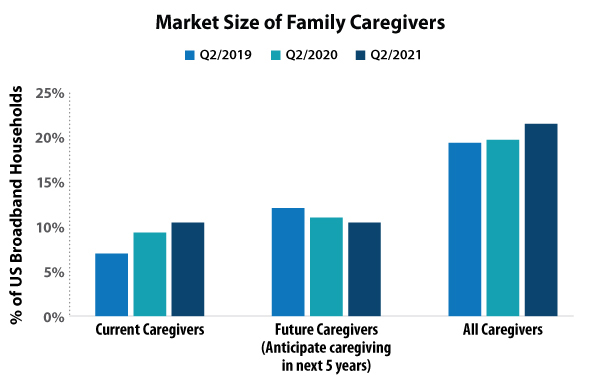In our latest consumer study, Healthy and Well at Home: Senior Assistive Technology, we found that as of 2021, some 22% of U.S. broadband households report either currently caring for a loved one or expecting to provide care in the next five years. A majority of the cared-for population resides in their own home or a relative’s home.

A growing number of companies, care providers, and investors are interested in tapping into this at-home care market, particularly the senior-care sector. This market encompasses private duty, home health, telehealth, remote patient monitoring, and independent living, among others. Home health startup AlayaCare’s recent funding round, at $225 million, was the largest ever in the U.S. home health space, signifying investors’ high level of interest in this market. With the senior care space heating up, the personal emergence response services (PERS) and remote patient monitoring (RPM) markets are additionally converging, with a growing number of PERS providers offering new RPM solutions.
In the past year we’ve seen big box retailer Best Buy double down on health and healthcare. In its retail stores, the company has doubled its vendor partners, growing its SKU count by more than 150%. Best Buy is additionally working with hospitals and care centers to curate health products for patients, and has launched a senior care ecosystem targeted to healthcare customers, particularly insurers. This new ecosystem combines its Lively Mobile mPERS solution, Geek Squad tech support, at-home health technology powered by new acquisition Current Health, and smart home platform Assured Living. New players are also entering into the PERS space, with smart speakers such as the Amazon Echo gaining PERS-like features and fall and emergency detection becoming almost standard on smart watches from Apple, Samsung and Garmin.
A key driver of this new attention on senior health is the growing use of telehealth and technology among seniors overall. Our consumer surveys find that from Q2 2019 to Q2 2021, telehealth use among the 65+ population surged from 6% to 42%. In addition, many seniors have become heavy users of digital communications tools, including apps such as Zoom and Facebook Messenger. Research shows that Zoom is more heavily adopted among older seniors than Facebook Messenger, reflecting older seniors’ preference for the PC and Zoom’s relative ease of setup compared to Facebook.
Demand for smart home functionality is also high among seniors and pre-seniors. We have found that while senior and pre-senior homeowners and apartment dwellers have different priorities regarding smart home functionality, interest in move-in-ready Wi-Fi, preinstalled video doorbells, smart door locks, and smart lighting are near-universal among both those looking to rent and buy.
The advent of COVID-19 caused a massive increase in telehealth and health tech adoption among all consumers and care professionals, but especially for older consumers and caretakers. These changes have had a permanent impact on the ecosystem, setting off a wave of new product development and new evolutions. The coming years will see further change, as care providers and systems increasingly turn to tech to increase efficiency, improve care outcomes, and help stem the gap on worker shortage.






